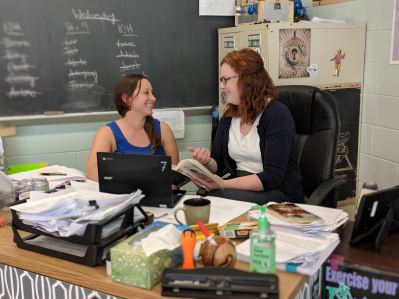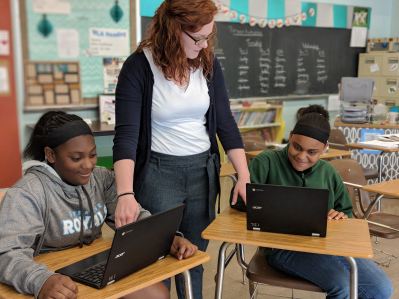Central New York Regional Information Center - Embedded PD Model: A One-On-One Approach to 1:1 Success
Professional development (PD) and training is a key component to high success rates of any new program. If teachers are well trained, implementation is more likely to result in success. But what kind of PD works best? I have given workshops, webinars, presentations, and online classes, to name a few types of ways to provide PD. The one question that always stuck with me was, “Does this even work?” It’s tough to spend enough time with each teacher to support their integration needs and help them continue to grow and learn. Teachers are already spread thin; they want to spend less time out of the classroom, not more. To work around this issue, I reinvented how I work with teachers, developing a model that does work.
For the past five years, I have worked with a multitude of districts across Central New York as a technology integration specialist out of two different Regional Information Centers (RICs). In the most recent three years, I have been assigned to the Roman Catholic Diocese of Syracuse Schools. At the Diocese, we have developed a professional development model for technology integration that truly works called the Embedded PD Model.
Before the implementation of this model of PD, I was trying to pull teachers out of the classroom, forcing the administrators to find substitutes where there were rarely any. I also tried to run online courses and webinars after school. To ensure all teachers’ availability, we made time all summer for teachers to have the chance to work with me or attend workshops at the RIC. When you want to see change and growth, you realize quickly that this doesn’t work well for most teachers. The teachers would “sit and get” and walk away, many quickly forgetting what they learned. And if they had questions, there wasn’t anyone there to answer them.
The majority of the 22 Syracuse Catholic schools have 1:1 devices in at least one grade level, if not more. Elementary schools are mostly 1:1 with Chromebooks in grades 3-6 and iPads in K-2. The high schools are all using Chromebooks in their 1:1 implementations. Most of my focus with PD has been the alignment of using G Suite, robotics, and other online tools to create activities that align with curricular standards. The SAMR model has been our base for technology integration as well as the ISTE standards for students and teachers.
In the Embedded PD Model, we rotate teachers through a three-day cycle of observation, one-on-one training and planning, and implementation. The days may be back-to-back or may occur every other day, but never more than two days in between. The three-day cycle allows me to differentiate PD for all teachers while building trusting relationships. Over the three days, I work alongside teachers one-on-one; I plan, assess, and re-plan based on the needs of each teacher.
The first day I spend observing while they teach. While watching an everyday lesson, I can get a feel for how the teacher teaches, interacts with students, utilizes technology, as well as the general flow of a typical lesson. This allows me to think about what they might be comfortable doing so that I can tailor my suggestions. I want teachers to move forward and try something new, but within their realm of abilities. I often take notes during my observation, especially if it’s my first time working with the teacher so that I can go back through before our meeting and have a few ideas ready to go that are tailored to their teaching style and the content they are teaching.
The second day, I meet with each teacher during their planning period; typically, we meet one-on-one. During this meeting, I ask questions about where they would like to go, what their goals are, what they may have tried in the past, and what they feel comfortable doing. Then, I ask questions about the lessons coming up, what kinds of activities the students will be doing, and what small assessments might be given. After I do quite a bit of listening and gauging what might fit that teacher, I give each professor two ideas to choose from. It might be as simple as posting a question in Google Classroom as a quick entrance ticket or as complicated as students taking notes from an online article in Google Keep to use in an essay written on Google Docs. Together, we plan what will be accomplished in the classroom on the third day. I spend time showing the teacher how to use the tool and helping them set up the lesson.
On the third day of embedded PD, I accommodate the teacher in the way that I believe would be most beneficial. I may sit in the classroom while the teacher tries the new activity, I may co-teach, or I may lead the lesson with the students. Some teachers need a cheerleader, others need an assistant, while others need an example.
Once the teacher sees success the first time, they gain confidence. I encourage them to continue doing the same type of activity for a few weeks to get the hang of it. Then, they feel ready to add a new tool or try something new.
Following up is incredibly important. Because I travel between 20 or so buildings, this most often occurs through email. In one instance, I spent three weeks in one of the high schools so that I could lead their initial 1:1 Chromebook program roll out. I was a part of the building for that time and PD just happened organically within the day. During those three weeks, I saw the most growth in teachers that I have ever seen. Even the eldest and most reluctant teacher is now using the Chromebooks to assign and collect assignments.
I love this model for so many reasons, but most importantly, it allows me to develop a relationship with the teacher. Working with them one-on-one allows me to get to know them not only as educators but as people. It gives them a chance to collaborate and work with someone that challenges them, someone who is there to answer questions and to work alongside them. I have seen some teachers who were technophobic, and at the start, stating that they refuse to work with technology in the classroom, transform into someone who starts to take risks and try new things in Google Classroom.
This was a unique model for our district because I previously was trying to manage providing teacher training to over 400 teachers all over Central New York (from Oswego to Binghamton, Syracuse to Utica). I didn’t feel like I was gaining as much traction as I thought I should. I didn’t feel connected. As a professional developer, I have always felt that building relationships is the most important component to helping teachers grow. If a teacher learns to trust me and sees that I will be there for them, they are more willing to try new things.
One critical piece of this method is the expectation from administration that these teachers work with me. It is not an opt-in session, and it is part of the way our district works. It’s not optional; it’s simply expected that teachers discover new ways to teach and learn to incorporate technology. This becomes part of the culture of the building. Harnessing the instructional leader in the building can be a challenge, but again, it all boils down to building relationships.
Contact
Katie Regan, Instructional Technology Specialist, Central New York Regional Information Center, kregan@syrdiocese.org







